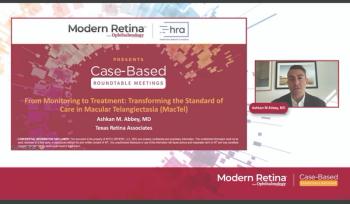
Timing is everything with early treatment of AMD
In a real-world setting, eyes with AMD with a relatively good initial best-corrected visual acuity and no fibrovascular pigment epithelial detachment sustained or improved BCVA after anti-VEGF therapy within 3 years of follow-up.
Japanese researchers, led by Risa Aichi, MD, and Norihiro Nagai, MD, found that eyes with age-related macular degeneration (AMD) with a relatively good initial best-corrected visual acuity (BCVA) and no fibrovascular pigment epithelial detachment (PED) achieved sustained or improved BCVA after anti-vascular endothelial growth factor (VEGF) therapy within 3 years of follow-up in a real-world setting.1 Drs. Aichi and Nagai are from the Department of Ophthalmology, St. Luke’s International Hospital, Tokyo.
These researchers retrospectively reviewed the medical charts of 104 eyes (104 patients) with AMD that were treated with anti-VEGF drugs and followed for 12 to 36 months.
The age-adjusted results showed that an initial BCVA < 0.3 logarithm of the minimum angle of resolution (logMAR) was a positive predictor (odds ratio [OR], 3.172; 95% confidence interval [CI], 1.029–9.783; P = 0.045) and the presence of a PED was a negative predictor (OR, 0.222; CI, 0.078–0.637; P = 0.005) of maintained/improved BCVA at the final visit.
They also found that eyes with an initial BCVA < 0.3 (Cox hazard ratio, 2.947; 95% CI, 1.047–8.289; P = 0.041) had a better survival rate after age adjustment when failure was defined as a BCVA reduction or 0.2 or greater logMAR unit.
In commenting on their findings, the authors explained that eyes with an initial BCVA < 0.3 were those of younger patients and that these eyes more often had “subretinal fluid as an exudative change and less frequently had intraretinal fluid, submacular hemorrhage, and fibrovascular PED. Initiating anti-VEGF treatment before BCVA declines and advanced lesions develop would afford better visual outcomes for AMD eyes in the real-world clinic, although further analyses are required.”
They continued, “Our results may help elucidate points requiring attention when examining eyes with AMD and the timing for offering treatment to this patient population in real-world settings. The results may also emphasize the importance of advising individuals to visit the eye clinic when they observe even minor symptoms and clinicians to detect AMD lesions at the early stage.”
Reference
Aichi R, Nagai N, Ohkoshi K, Ozawa Y. Impact of treating age-related macular degeneration before visual function is impaired . J Clin Med. 2022;11(19), 5726; doi:10.3390/jcm11195726
Newsletter
Keep your retina practice on the forefront—subscribe for expert analysis and emerging trends in retinal disease management.












































